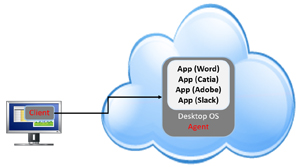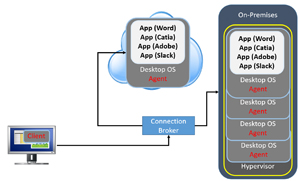How-To
Tips for Managing VDI, Part 6: Infrastructure Options
In my previous article I looked at the two most prevalent technologies being used with VDI today, converged infrastructure (CI) and hyperconverged infrastructure (HCI). In this article I will look at two emerging infrastructures for VDI: Desktop-as-a-Service (DaaS) and hybrid infrastructure.
DaaS
DaaS involves delivering desktops from the cloud. This was one way people got around the problem of obtaining physical servers and managing the infrastructure involved with VDI in the early days of the pandemic.
DaaS may decrease IT operation costs, but it may cost more per desktop than running them on-premises. At the bottom of this article, I will cover some of the tradeoffs when using them.
 [Click on image for larger view.]
[Click on image for larger view.]
Hybrid Infrastructure
Many VDI providers offer a hybrid solution where users can use on-premises or cloud-based DaaS in conjunction with their on-premises desktops. This allows companies to quickly deploy new desktops without having to acquire and set up new hardware in a datacenter.
 [Click on image for larger view.]
[Click on image for larger view.]
Advantages of DaaS over VDI:
There are advantages to using DaaS over traditional VDI solutions.
- Easier to implement and administer than VDI as it can be as simple as opening a browser on your desktop that supports HTML5.
- Doesn't require a virtualization or VDI experts on staff.
- Deploy desktops on-demand to meet end-user needs. There is no need to acquire and set up additional hardware.
- You can see how it performs in full production capacity, under load, without a big financial outlay upfront.
- Pay only for what you use as there is no upfront investment.
- No CapEx cost as it is entirely OpEx.
- Easy to enable a bring-your-own-device (BYOD) stratagy.
- There are many different DaaS providers and solutions. When selecting a solution, there are a range of key considerations, such as where the solution is hosted, performance levels, scalability, security, data location and cost.
Advantages of On-Premises over DaaS:
DaaS requires very little if any upfront costs, but on-premises VDI may be cheaper in the long run, depending on the specifics of the deployment. While DaaS providers have lower upfront expenditures due to no CapEx investment, the cost of DaaS deployments vary depending on the subscription model and the features included -- such as VM instance size and the software entitlements (licenses).
Regulatory requirements of specific industries and countries may not allow DaaS. For examples, the healthcare industry has HIPAA regulations, and the financial industry has SEC regulations. Different regions have regulations around data sovereignty, such as General Data Protection Regulation (GDPR) rules in the European Union. These regulations my disqualify DaaS.
VDI provides greater control over the virtualized desktops and the underlying hosting virtualization infrastructure. For example, there may be technical requirements that DaaS does not have, such as USB redirection or using multiple monitors.
VDI also allows greater control over support if you already have a VDI support organization in place.
DaaS or VDI
One of the questions many companies have is should they go with DaaS or VDI. I would suggest that for many companies a hybrid approach is the best solution as it allows them to use their existing resources but gives them additional flexibility in the management of resources while shifting some of their budget to an OpEx from a CapEx model that DaaS provides.
 [Click on image for larger view.]
[Click on image for larger view.]
In the next and final article, I will take a look at a best practice to ensure that a new VDI implementation is successful and discuss one of the reasons VDI failed in the early days and what we did to overcome it.
About the Author
Tom Fenton has a wealth of hands-on IT experience gained over the past 30 years in a variety of technologies, with the past 20 years focusing on virtualization and storage. He previously worked as a Technical Marketing Manager for ControlUp. He also previously worked at VMware in Staff and Senior level positions. He has also worked as a Senior Validation Engineer with The Taneja Group, where he headed the Validation Service Lab and was instrumental in starting up its vSphere Virtual Volumes practice. He's on X @vDoppler.